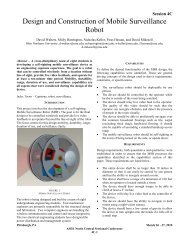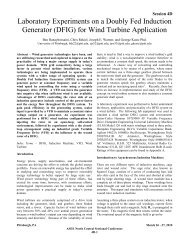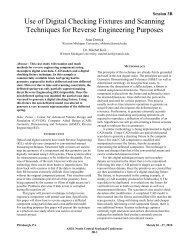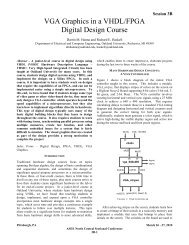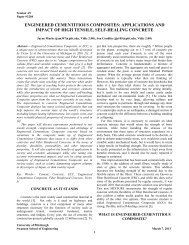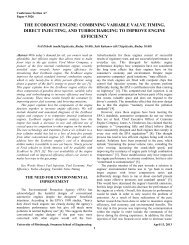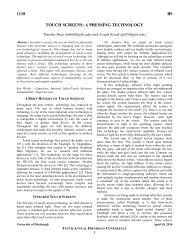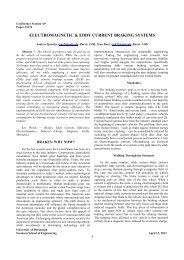Create successful ePaper yourself
Turn your PDF publications into a flip-book with our unique Google optimized e-Paper software.
achieve its three-second-answer time for every “Jeopardy!”<br />
question. If Watson were to use one processor, it would take<br />
about two hours for it to answer just one question. What<br />
allows Watson to achieve this speed is a combination of<br />
hardware and software. IBM used the Apache Unstructured<br />
Information Management Architecture to sort through the<br />
large amount of information that Watson has stored on its<br />
hard drive. This architecture allows Watson to spread the<br />
processing load across all 2,880 of its processor cores at<br />
once.<br />
Watson has proven that a computer is able to interpret<br />
text and use data that it already knows to answer a question<br />
given the right hardware and software, which is great for<br />
business and computing applications. This is also promising<br />
for the field of robotics in that robots could benefit from the<br />
ability to process this much data all at once and to interpret<br />
visual commands and search an internal database to<br />
determine the best course of action. One way to make robots<br />
more capable is to enable them to make decisions on how to<br />
use their hardware based on the task at hand. For example,<br />
traversing over snow, ice, mud, and sand all require different<br />
movement techniques and if a robot were to move through<br />
this terrain without compensating for the instability of snow<br />
or the slickness of ice, it could get stuck or fall and become<br />
damaged.<br />
While Watson is a good example of computing methods<br />
for rapidly inputting information and finding the best<br />
solution, the fact that it takes up over 180 cubic feet and<br />
consumes as much power as a laundromat makes computer<br />
processing at this scale impossible for mobile robots. Ideally<br />
the parallel processing power and statistical analysis of<br />
Watson would be combined with the size, power<br />
requirement, and reliability of Voyager’s computers.<br />
Nonetheless, lessons such as building computers for a<br />
specific purpose and using distributed computing could be<br />
applied at a smaller scale, making robots more autonomous<br />
[20].<br />
THE PERFECT EXAMPLE: BIGDOG<br />
What is BigDog?<br />
Finally, after discussing control systems, sensors to give<br />
them information, and the benefit of further engineering<br />
research in the speed of computers, we come to a vital<br />
example that exhibits all of these: BigDog. Released in<br />
2008, BigDog is Boston Dynamics’ four-legged robot. The<br />
BigDog project’s goal is to create a robot that can travel<br />
anywhere an animal or human can go. BigDog’s control<br />
system must balance, navigate, and regulate all forms of<br />
movement. Three areas were emphasized in the area of<br />
control: supporting the body through bouncing, controlling<br />
attitude of the body with torques, and key placement of feet<br />
to keep the body symmetric. By utilizing this state of the art<br />
technology with a complex quadruped, BigDog exemplifies<br />
Paper 1018<br />
the correct direction in which intelligent robotics research<br />
should be going [21].<br />
FIGURE 9 [22]<br />
BigDog’s Sensing Ability<br />
BigDog has the ability to sense its surroundings and react to<br />
them in order to keep from falling. It also has the ability to<br />
detect future movements, such as good foot placement.<br />
When a human walks over ice, they do so carefully, looking<br />
for good footing while not shifting too much weight onto a<br />
foot. A robot can hardly know exactly where to place a foot,<br />
and therefore the ability to foresee future movements are<br />
vital.<br />
BigDog has been equipped with close to seventy sensors.<br />
About fifty of these sensors are located on the hips, knees,<br />
ankles, and legs, measuring aspects such as joint<br />
dislocations, force approximations, and servo current.<br />
Without these necessary sensors, BigDog would collapse<br />
when traversing even the easiest terrain. Aside from leg<br />
sensors, six others are gyroscopes used to measure the<br />
body's balance, while three more are used for vision<br />
approximations, such as avoiding obstacles, measuring the<br />
ground slope, or finding patterns in the motion of the<br />
surroundings [22].<br />
BigDog has been proven to have good stability, even<br />
when walking across ice or up an unstable hill. These<br />
sensors are a large portion of the reason why the machine is<br />
so successful, as the data sent to the control system must be<br />
accurate. But, even with an extreme amount of information,<br />
if the computer cannot process and make decisions quickly,<br />
the machine as a whole will still fail.<br />
BigDog’s Stabilization<br />
As previously stated, a legged robot can travel on more<br />
difficult terrain than a treaded one due to its ability to<br />
compensate for small mounds or ditches, but the difficulty of<br />
balancing these robots is great. BigDog's torso weighs about<br />
University of Pittsburgh Swanson School of Engineering<br />
Eleventh Annual Freshman Conference April 9, 2011<br />
6




